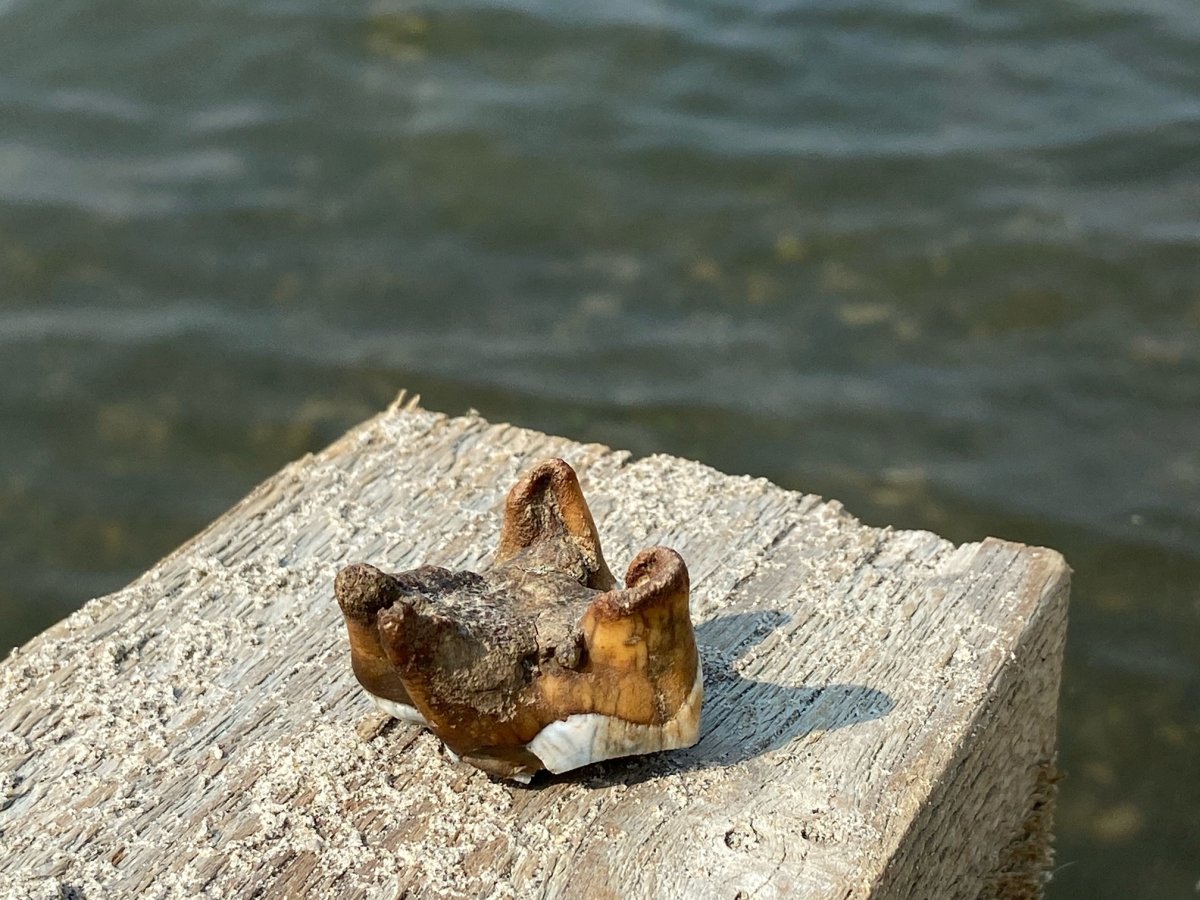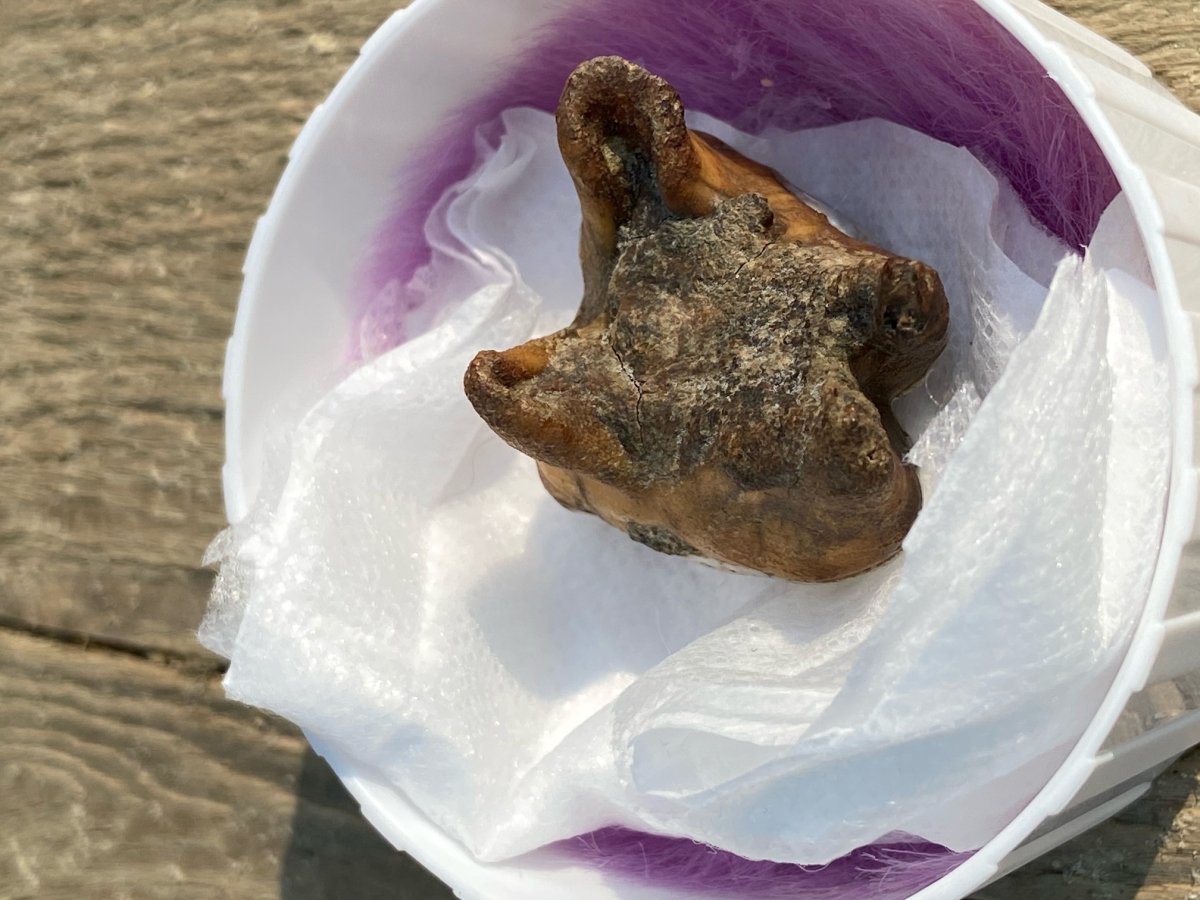By Sarah Ryan Global News
Posted August 3, 2021

WATCH ABOVE: Sarah Ryan tells us how a young girl came across a unique fossil at an Alberta lake.
At six years old, Abby Darby made an incredible discovery, all while playing with rocks.
“On the beach sand, I thought I saw a cool rock. But then I dug it out and it wasn’t a rock,” she explained.
Knowing she had something special, she ran to show her family the unusual find.
Right away, they agreed the specimen was likely a fossil.
“I thought after that it would be really cool if I could tell her exactly what it was, because we all had our guesses,” explained Darby’s aunt, Krysta Poole.
“Grandma, she had a claw guess. but all the other ones thought it was a tooth,” Darby said.
READ MORE: Friends recover ancient fossil in Edmonton’s river valley: ‘Like finding a needle in a haystack’
Poole sent a video of Darby’s find to the Faculty of Science at the University of Alberta.
Mark Powers, a PhD student in vertebrate paleontology, took a look at it and said “it’s definitely a tooth, you can see it right away. And it’s definitely mammal because it has the multiple roots. A lot of what we see in dinosaurs or lizards is a single root.
In addition to the roots, he compared the cusps and pits of the tooth to other fossils.
“Upon looking at some specimens here at the University of Alberta in our teaching collections, I can confirm it’s definitely a camel family member.”
A camel, on the Canadian Prairies? Powers said camels are believed to have originated in North America, though they would have looked very different than the ones we have today.
The University of Alberta’s collection includes a small skull from a camel found in Wyoming, for example.
It’s estimated this fossilized tooth would be between 22,000 and 25,000 years old.
“There were huge glaciers that were covering most of Alberta during that time,” Powers said.
“So there would have been some ravines where the ice sheets were retreating away from each other, where we would get a lot of water influence from the melting glaciers. That’s where animals probably would have hung out.”
At six years old, Abby Darby made an incredible discovery, all while playing with rocks.
“On the beach sand, I thought I saw a cool rock. But then I dug it out and it wasn’t a rock,” she explained.
Knowing she had something special, she ran to show her family the unusual find.
Right away, they agreed the specimen was likely a fossil.
“I thought after that it would be really cool if I could tell her exactly what it was, because we all had our guesses,” explained Darby’s aunt, Krysta Poole.
“Grandma, she had a claw guess. but all the other ones thought it was a tooth,” Darby said.
READ MORE: Friends recover ancient fossil in Edmonton’s river valley: ‘Like finding a needle in a haystack’
Poole sent a video of Darby’s find to the Faculty of Science at the University of Alberta.
Mark Powers, a PhD student in vertebrate paleontology, took a look at it and said “it’s definitely a tooth, you can see it right away. And it’s definitely mammal because it has the multiple roots. A lot of what we see in dinosaurs or lizards is a single root.
In addition to the roots, he compared the cusps and pits of the tooth to other fossils.
“Upon looking at some specimens here at the University of Alberta in our teaching collections, I can confirm it’s definitely a camel family member.”
A camel, on the Canadian Prairies? Powers said camels are believed to have originated in North America, though they would have looked very different than the ones we have today.
The University of Alberta’s collection includes a small skull from a camel found in Wyoming, for example.
It’s estimated this fossilized tooth would be between 22,000 and 25,000 years old.
“There were huge glaciers that were covering most of Alberta during that time,” Powers said.
“So there would have been some ravines where the ice sheets were retreating away from each other, where we would get a lot of water influence from the melting glaciers. That’s where animals probably would have hung out.”
Darby’s aunt was surprised to hear the news.
“I never knew camels were around here,” Poole said. “We could have never guessed that ourselves.”
She quickly shared the findings with her niece.
“I thought that it was amazing,” Darby said.
Powers said by analyzing the tooth’s enamel and isotopes, researchers could learn a lot.
“That can actually give us an indication of migration, diet and all sorts of changes in their environment as they grew,” he said. “Mammals are great for that because all of it is recorded in the enamel, and most mammals only have two sets of teeth in their life.”
Darby’s family plans to donate the tooth to the Royal Alberta Museum.
“So next year, when I’m in Grade 1, I can show my friends,” Darby explained.

Sarah Ryan / Global News
24

24

Sarah Ryan / Global News
34

34

Sarah Ryan / Global News
44

44

Sarah Ryan / Global News
No comments:
Post a Comment